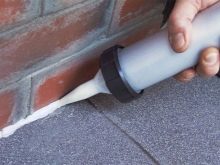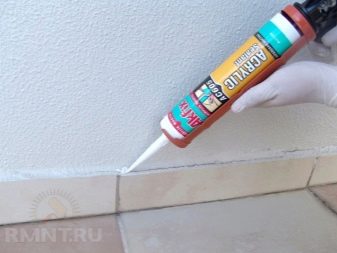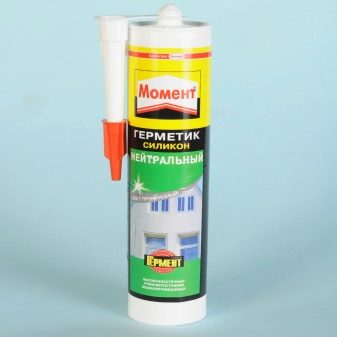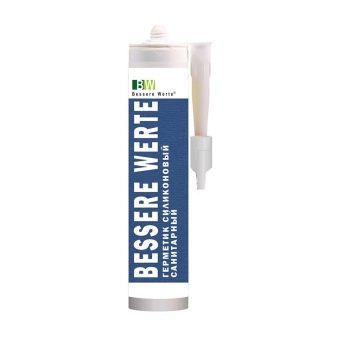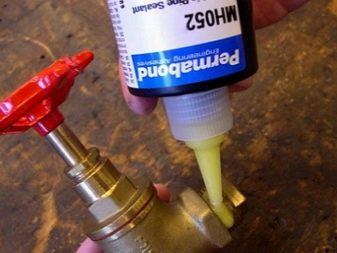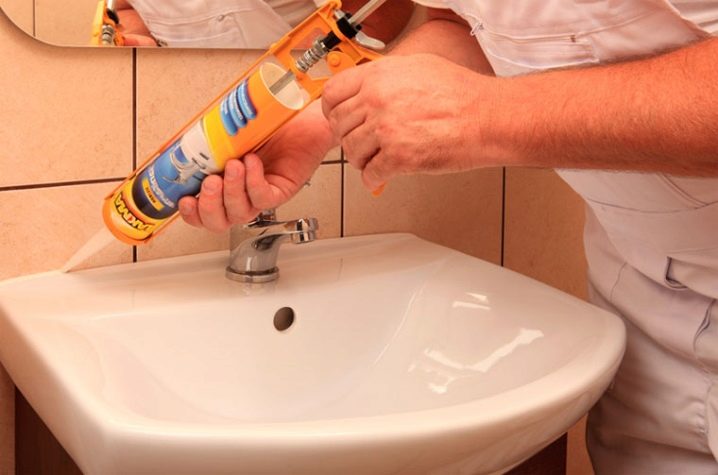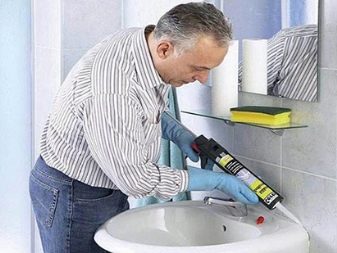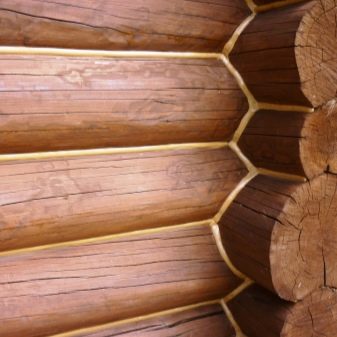Sealant: types and scope of application
Whatever types of construction work are carried out inside the house, sooner or later there comes a time when all sorts of joints between tiles, boards or other structures must be sealed. Get rid of ugly cracks, give the site a finished look and prevent the penetration of cracks in the liquid droplets and / or air sealants help. Today the market of building materials offers a large number of a wide variety of sealants, which differ depending on the composition, the final appearance and scope of application.
Special features
First you need to figure out what sealants are. Most of them are pasty or heterogeneous viscous mass, created on the basis of polymers or oligomers.
Sealants are designed to protect a variety of surfaces from excessive moisture., gaseous substances and household and other pollutants. They fill the gaps and joints between structures: voids near the pipes - heating or plumbing, gaps in the window frames, the space between the walls and the door frame, ventilation systems - these are just a few of the possibilities for using these tools at home.
Most modern compositions, in which quality you can be sure, are designed to create a very strong and durable sealing layer. They interact perfectly with wooden, stone, brick, concrete, plastic, glass and metal surfaces, resistant to high humidity and temperature changes. By itself, the sealing layer is an elastic coating that is impermeable to water vapor and other fumes.
Such compositions, if you resort to products of trusted manufacturers, are quite reliable. During operation, they are completely safe, because they do not emit any hazardous substances.
Purpose
The main task of sealants is to ensure the tightness of joints and joints between elements of various designs.
Sealants are used in many areas. They are able to isolate certain parts of the plumbing or heating pipes in order to save space from voids or high humidity.
Some types of sealing compounds are necessary for insulation of premises. It is not uncommon for such compositions to be used in facade construction works. They are able to qualitatively and easily seal the roof and foundation.
Sealing compounds are applied to the bolted, locking connections, seam structural elements to provide waterproofing. They are necessary to ensure sealing at the joints of flexible joints. Where other materials may create voids, the composition will simply fill them.
Types and characteristics
There are several main classifications of sealants. In addition to the division into one-component and multi-component compositions, they can be distinguished by the type of hardening.
- Drying out. They harden after the water evaporates or the solvent used in them, and also shrink considerably after drying.
- Curers. These compounds are suitable for further work under the influence of water / solvent or air, less often - after mixing all the components together.After hardening, these compounds appear rubber.
- Non-hardening. Such compositions look like plasticine. Such mastic freezes only after adding special substances to it.
The most common and important classification considers the properties of different compositions depending on the substances and compounds that are included.
Silicone
Silicone sealants have the most universal composition. With equal success, they are used in both internal and external repair work. They have outstanding adhesion to a wide variety of surfaces - stone, concrete, metal, glass, wood and ceramics, and also quickly polymerize. In addition, silicone mixtures are quite resistant to aggressive chemicals, tolerate high humidity, as well as active exposure to ultraviolet rays.
There are several undoubted advantages of silicone sealants. First, it is their high elasticity, due to which such a substance is often used to ensure the tightness of mobile joints. Secondly, the service life of silicone sealants is on average from 15 to 20 years.Thirdly, these substances are safe for health and environmentally friendly.
The composition of silicone mixtures can be one- or two-component. The main substance in any case remains the silicone polymer, namely silicone rubber. In addition, the composition can be found dyes (usually in decorative varieties), fungicides (their task is to prevent the development of mold), mechanical fillers (they should contribute to improved adhesion).
Single-component rubber sealants are used in everyday life. They harden due to moisture in the air. Otherwise, two-component mixtures are used: they are used mainly in industry, since for their curing it is necessary to use special formulations.
In turn, one-component silicone sealants, depending on the base, are further divided into three subspecies.
- Acidic, as the name implies, contain acid - acetic. Therefore you should not be afraid if during the curing process the substance will emit a characteristic acidic odor. Despite this, these compounds, like all silicone blends, are safe and environmentally friendly.This type of silicone sealant is suitable for work only with acid-resistant materials, that is, wood, plastic and ceramic products, but with products made from other materials, especially metal, you cannot use them.
- One of the components of a neutral sealant can be alcohol or ketoxime, which ensures its versatility.
- The third type is alkaline sealants. They are made with the use of amines and are used in domestic areas extremely rarely.
There are some other types of silicone sealants. Silicate is heat-resistant and can withstand temperatures up to 1200 degrees Celsius. Epoxy glue is also suitable for sealing up various cracks, crevices and joints: it is more difficult to apply it than its counterparts, the curing time is about a day, but this glue itself is colorless and transparent.
There is also a self-expanding sealant that begins to expand some time after application to the surface. This allows you to fill the gaps as much as possible and to ensure complete sealing of the seam.
In addition, these sealants are thermally conductive and allow you to warm the room, if used to seal pipes related to heating systems.
Unfortunately, this kind of sealing compounds is not without some drawbacks. Firstly, silicone sealant (if it was originally the wrong color that the owner needs) cannot be painted later. Secondly, silicone compounds very poorly fall on the old layers of other sealing compounds: in most cases it will be necessary to completely dismantle the old layer, which can cause certain difficulties.
Many types of sealing compounds after solidification become vapor-permeable. Vapor-permeable sealant has high strength, it is more resistant to deformation and adverse weather conditions.
Acrylic
This type of sealant is used mainly for interior work, because it is not elastic enough, although it is quite cheap. These compounds are a mixture of several acrylate polymers.
Often, after application, acrylic sealants are coated with acrylic paints or varnishes. In addition, the cost of this kind of sealing compounds is much lower than, for example, silicone.
All sealing compounds, created on the basis of acrylic polymers, can be divided into waterproof and non-waterproof. The first ones are odorless and absolutely safe for the health of the people living in the apartment, but at the same time they tolerate very poorly the deformation - using them on surfaces expanding under the action of temperatures will be destructive. This composition is also experiencing bad moisture.
Waterproof compounds are known for their high adhesion to most types of surfaces, including concrete, PVC, drywall and even plaster. In addition, some of the acrylic sealants have flame retardant properties.
Polyurethane
Very flexible, but at the same time resistant to various types of deformation, a type of sealant, created on the basis of polyurethane and some polymer components. Due to its strength, this material is often used in roofing works or in strengthening the foundation. Like silicone sealants, one-component and less often two-component polyurethane compositions are found.
This material has excellent adhesion to reinforced concrete, aluminum, plastic, ceramics, wood and stone. Among its advantages - resistance to conditions of high humidity, temperature drops (from -60 to +80 degrees Celsius), active exposure to ultraviolet radiation.
Despite the fact that urethane sealants seize quickly, it will take about ten hours for them to fully cure. Since the composition is applied directly from the tube in which it was purchased, or using a special pistol, it will not spread over the surfaces.
Bituminous and rubber
This kind of sealing compound is a paste-like composition, based on a binder bituminous substance and some additional fillers, designed to strengthen the composition and ensure its resistance to hostile environmental factors.
Such compounds are very flexible and heat resistant. They are not afraid of high humidity, exposure to ultraviolet radiation and medium mechanical effects. It is simple to work with them, and high adhesive characteristics allow not to clean the surface before applying a sealant on it.
Flange sealant can sometimes be distinguished by areas of application: it is used to strengthen connections and seal surfaces with large gaps. Due to its structure, it does not drain from vertical surfaces, which gives it an advantage to use, for example, on the ceiling.
Colors
Different types of sealants, depending on the composition have different colors and shades. The most diverse in this regard is silicone sealant. Since after application and hardening, it cannot be colored, manufacturers try to create their products in different colors. The most common are white, beige, red, brown, blue colors.
If for the consumer the color does not play a decisive role or it is very difficult or even impossible to choose the desired shade, then existing colorless compositions can be used.
Consumption
Calculate the amount of sealant needed is very important immediately before starting work. This will not only greatly facilitate the process of repair work, but will also save.
For accurate calculation of material consumption, it is necessary to know the exact dimensions of the gap, opening that will need to be filled with a sealing compound. The width and depth indicators, taken in millimeters, are multiplied, and the result obtained shows the consumption of the sealing compound per 1 m of the seam in grams.
If it is planned (or known in advance) that the gap that needs to be sealed,has a triangular shape, then the product of the width and depth is further divided by two, the mixture consumption in this case is significantly reduced. Usually such seams are encountered when processing surfaces that are perpendicular to each other.
Sealants (in particular, silicone) are sold in containers of various shapes and sizes. To find and select a tuba of the correct volume, you need to make another simple calculation. From the calculation of how many grams of the composition will be required to fill the gap, the most optimal variant by weight is selected.
Some manufacturers produce formulations that are sold immediately in the tubes created in such a way that the repairmen only need to cut off the nose, after which they can comfortably begin to fill the gaps and seams. For some types, it will be necessary to additionally purchase a special construction syringe, which will allow dispensing the quantity of the compound entering the cracks.
There is also a sealant spray sprayed directly onto the surface that needs to be sealed, but it is used much less frequently than silicone counterparts.
Manufacturers
On the market you can find a huge number of factories producing sealing compounds designed for different applications. Most manufacturers try to make the same type of sealants depending on their composition and purpose. It is worth considering some of the most popular and proven firms.
Acrylic sealant for wood produces, for example, the company Remmers. The product itself is called - Remmers acryl. This tool, like most acrylic sealants, is characterized by high elasticity, it is very flexible, can withstand low temperatures, resists well the high humidity. It is also important that the product produced by this company is an environmentally friendly composition, completely safe for human health.
At the base Remmers acryl Acrylic polymers lie, thanks to which this composition is distinguished by high elasticity and resistance to adverse weather conditions. No solvents or antiseptics are added to the mixture, which means that the agent turns out to be more versatile, the scope of its application is significantly increased.
This sealant can be used to seal cracks, sealing joints in various wooden structures. This will ensure the preservation of heat in the room, prevent the ingress and accumulation of moisture and dirt in the crevices and seams.
Swiss sealants Sikaflex They are famous for their worldwide renowned Swiss quality. It produces sealants of different types, they can be applied in a wide variety of fields. All products of this company are very easy to repair: convenient packaging, ease of use, high adhesive properties to a variety of materials. In addition, Sikaflex products are almost odorless and highly ecological.
The main types of adhesives and sealants that the company produces Sika, extremely diverse. This and universal polyurethane sealants - they are used to connect parts in places with high loads; bituminous suture sealant (allows to fill cracks and seams in surfaces made of concrete and stone, is actively used in roofing and repair work of water supply systems, in particular - drainage), the most neutral silicone sealant (the most common and universal option in repair work).
The sealing compounds from Sika company are distinguished by a relatively wide choice, favorable price and high quality of the products offered on the market.
Company Permatex It is considered the unsurpassed leader in the production of various adhesives and sealants used for car repairs. Despite the rather narrow scope of application, the quality of these products is at a fairly high level. These sealants are used in automotive plants and services around the world.
How to choose?
Depending on its composition, sealants differ in both their basic properties and scope of application.
Acrylic sealers are commonly used to seal joints., cracks and splits in a variety of stone and / or concrete surfaces. Also, this type of sealant is suitable for wood: floor boards, interior door boxes and window openings. All kinds of communication pipes, forming joints in bathrooms, kitchens and bathrooms can also be sealed with acrylic formulations.
Silicone sealants have an even broader scope.Due to their properties, they are actively used both in indoor works and in external works outside the house. Such compositions are used during the installation of doors. They are used for warming window frames and balconies. In addition, silicone sealants are used in bath rooms for sealing baths, sinks, showers, toilets - they are indispensable for working with water pipes, ensure complete tightness, preventing the penetration of odors, water and noise. Silicone sealants can be used when working with cable glands; due to their high adhesion properties, they are also used when working with metal.
Due to the wide range of temperature tolerated, silicone sealants are best used for sealing heating systems, chimneys and ventilation.
For roofing and sealing the roof, sealing the joints between the sheets of corrugated board, less deformational and dense bituminous or rubber sealants are used: they allow to fix the roofing material, fix polystyrene foam and other insulating materials. In addition, they are used to seal all kinds of cracks in the foundation of houses, the ends, as well as the seams between the sandwich panels.
Spray sealants are used to take care of car details (for example, the steering rack, repairing cracks in the housing and between the joints of fixed joints).
Also, when choosing a sealant, you should pay attention to its color. After all, if you plan to use a sealing compound in places hidden from the eyes of residents (in sealing water and heating systems, for example), you can use a colorless composition - the color in any case does not play a special aesthetic role, because it will simply not be visible. Another thing is if the work will be carried out on visible parts of the surface: in such cases it is worthwhile to attend to and find the shade of the sealant that best suits the color.
This is especially important for silicone sealants, which, after being applied to the surface and solidify, cannot be painted.
Application
Depending on the type of sealants, it is necessary to take into account the individual characteristics and requirements of each of the compositions. For example, before applying any type of silicone sealant, it will be necessary to degrease and thoroughly dry the surface.Bituminous, on the contrary, do not require thorough cleaning of the working surface: they are very elastic, resistant to precipitation and other adverse weather conditions, have high adhesion properties, which makes them indispensable for external repair work.
Drying times can also vary considerably. Many sealants are drying compositions that harden and get the necessary properties after the water or solvent is evaporated. For some formulations, a special component is needed that will help the sealant to harden.
Silicone sealants are covered with a film within 10–15 minutes after they are applied to the surface, and their hardening rate averages from 2.5 to 4 mm per day. Depending on the polymers, acrylic sealants can be coated with a primary film from 5 to 20 minutes, their hardening rate is much higher and ranges from 2 to 3 mm per hour. Bituminous and rubber sealants harden a little slower: when a primary film is formed in the first 12-16 minutes after application, the rate of their hardening averages 2 mm per hour.
Use a sealant to help special construction syringes and pistols, where the finished composition is poured, or in some industries, manufacturers immediately produce sealing compounds in convenient tubes, in which it is enough to cut a hole and begin to apply in their repair work.
In order to properly apply colored sealant, you need to remember which of them can be applied on a wet surface, and which require thorough pre-drying.
Useful recommendations
Before repairing, it is necessary to carefully examine all the main types of existing sealants in order to acquire the exact composition that will be most suitable for the chosen type of work.
We must not forget that a completely universal sealant for repair does not exist, each of the materials is distinguished by its unique features and, where one type is ideally suited, the other will not be able to withstand the loads intended for it and will destroy itself or damage the surface on which it is applied.
Professionals recommend using bitumen for sealing seams in concrete and stone (and in general) and less often silicone sealants.Acrylic is suitable for wooden houses or interior elements (for example, door frames). Polyurethane or bituminous sealants are ideal for roofing. This will be a particularly successful solution for a roof made of metal.
In interior work, it is still common to use silicone sealants. - they easily seal joints between plumbing fixtures and walls, also help in waterproofing and sealing pipes.
To eliminate leaks in plumbing systems and pipes of heating systems, special liquid sealants are often used. When sealing leaks in metal parts, different types of silicone sealants are used, but only the most neutral varieties, since containing acetic acid will inevitably cause corrosion and destruction of the metal. Moreover, such a sealant must not only withstand high water pressure: it must also be resistant to high temperatures.
Many sealants are not only able to tolerate temperature extremes, which allows them to be used in various fields. They also easily survive work at sub-zero temperatures — for example, polyurethane sealants. They can be applied at temperatures up to -10 degrees Celsius.
It is important to pay attention to the temperature amplitude that the sealant manufacturer specifies on the packaging. This will affect the final properties of the tool and the place where it will be applied. In addition, it is important to take into account the climatic features of the region in which the sealant is used, if it is used for external works.
For more information on the types and application of sealants, see the following video.


